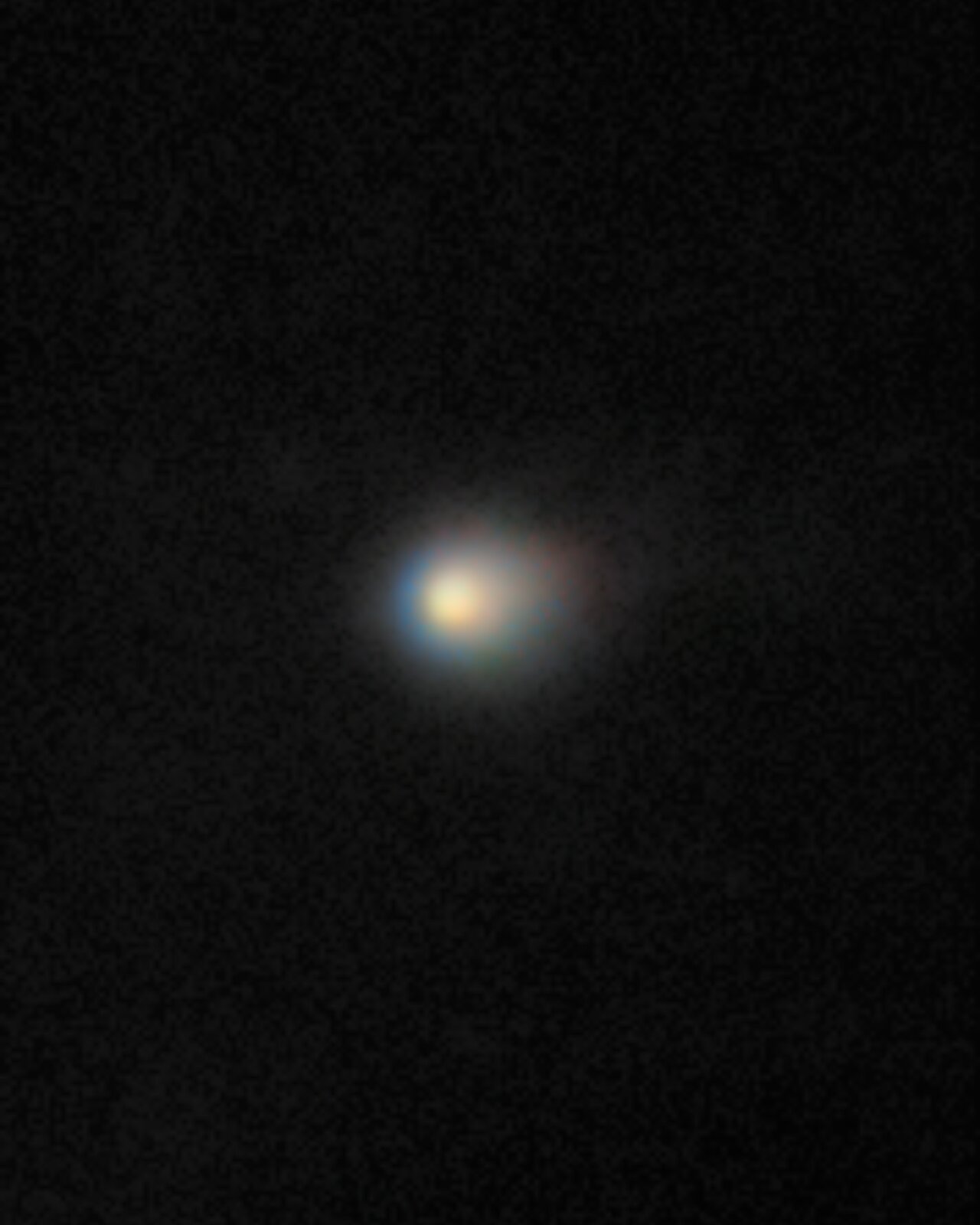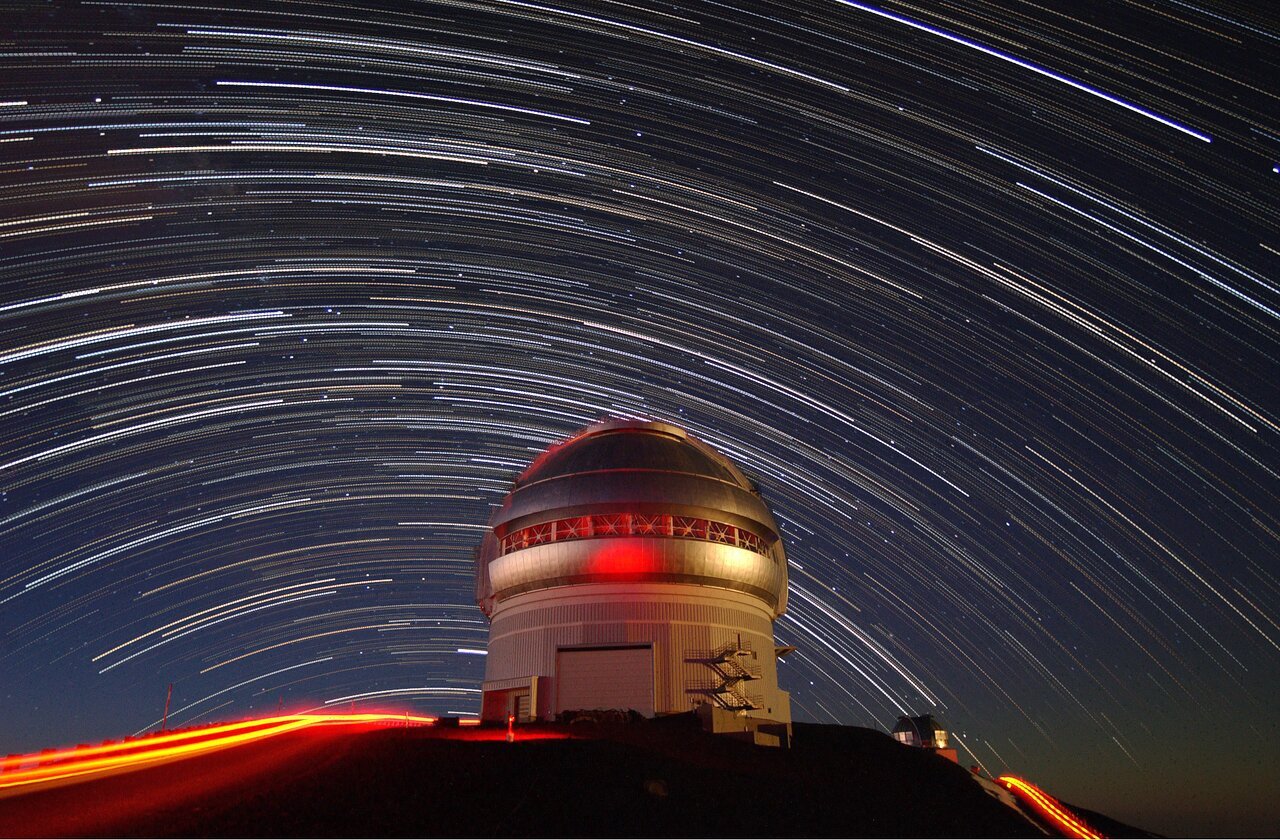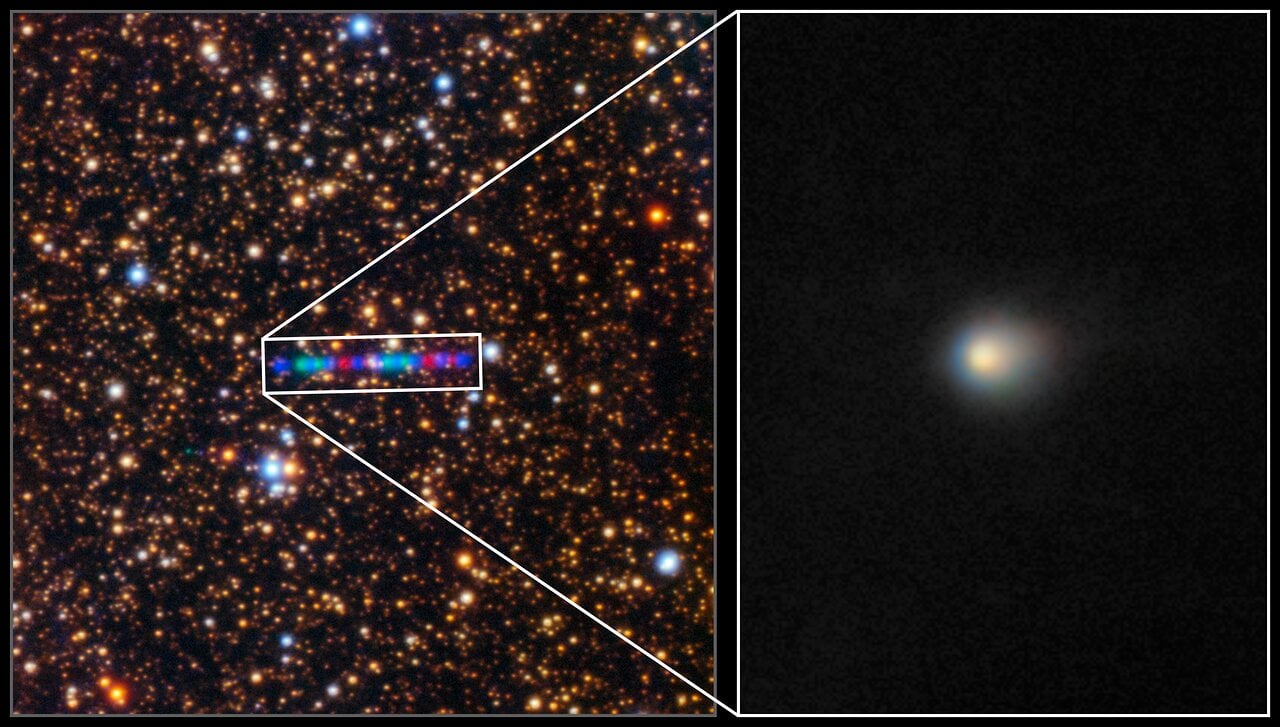One of the world’s most powerful instruments reveals interstellar comet 3I/ATLAS as it heads towards perihelion.
We’re getting better views of interstellar Comet 3I/ATLAS, as it makes its speedy passage through the inner solar system. This week, astronomers at the Gemini North observatory located on Mauna Kea in Hawai’i turned the facility’s enormous 8.1-meter telescope on the object, with amazing results.
You can definitely see the dusty coma forming around the comet’s nucleus in the images as it approaches the inner solar system. The multi-colored hues of the images are thanks to Gemini’s Multi-Object Spectrograph (GMOS-N) which will probe 3I/ATLAS across infrared and visible wavelengths.
Comet 3I/ATLAS crossing the dense galactic plane. The colors are due to the separate filters used on the GMOS-N spectrograph instrument. Credit: NOIRLab/AURA/Gemini North/IfA University of Hawaii.
“3I/ATLAS is currently passing in front of the very dense star fields near the galactic center in Sagittarius,” astronomer Karen Meech (University of Hawai’i Institute for Astronomy) told Universe Today. This makes it very challenging to find windows of time where we can get a good observation of the interstellar object that is not contaminated by passing over stars.”
 The resulting combined image of 3I/ATLAS, revealing the teardrop shaped coma, characteristic of a comet. Credit: NOIRLab/AURA/Gemini North/IfA University of Hawaii.
The resulting combined image of 3I/ATLAS, revealing the teardrop shaped coma, characteristic of a comet. Credit: NOIRLab/AURA/Gemini North/IfA University of Hawaii.
As is always the case in modern astronomy, observing time comes at a premium. “Gemini is a ‘queue scheduled’ telescope, meaning observers prepare the observing sequence and the staff at the telescope execute the observations based on priority, best match to observing conditions etc,” says Meech. “For a high priority observation, this ensures you get the data. Using telescopes in the classical mode where an astronomer is assigned a night might mean you lose the night because of bad weather or instrument problems. The Gemini staff were fantastic and really went above and beyond what is expected in order to ensure these observations were successful.”
 Star trails over the Gemini North Observatory. Credit: International Gemini Observatory.
Star trails over the Gemini North Observatory. Credit: International Gemini Observatory.
3I/ATLAS also seems to be a very red object, reminiscent of KBOs such as 486958 Arrokoth, one of the only KBOs seen up close during New Horizons’ 2019 flyby.
This effort will help answer the main question currently on astronomer’s minds: how big is 3I/ATLAS? Current size estimates for the nucleus span a range from just under a kilometer to over 20 kilometers across—definitely larger than the other two known interstellar objects: 1I/’Oumuamua and 2I/Borisov.
“All small bodies rotate, so we interleaved images in the blue filter in between all the other filters so that we could get accurate colors of the object,” says Meech. “The brightness we see through the filter depends on how reflective the surface is at that wavelength, and the area of the surface reflecting sunlight. If it is rotating and you don’t have the same filter repeated in between each observation, then you can’t tell what is a change because of the color area. These images showed that 3I/ATLAS is ‘red’—meaning it reflects red light more strongly than blue light. This is what we usually see for comets in our solar system. The ‘red’ color is due to organic compounds on the surface for solar system comets.”
Currently just under 4 Astronomical Units (AU) from the Sun, 3I/ATLAS will pass perihelion 1.356 AU from the Sun on October 29th. Closest Earth passage is set for December 19th, at 1.8 AU distant. Mars actually gets the best seat in the solar system, on the 0.2 AU pass on October 3rd. We recently wrote about observing prospects for amateur astronomers leading up to and after perihelion here.
Where is interstellar comet 3I/ATLAS headed—and how close will it come to Earth? ☄️Using the latest data from @NASAJPL, we mapped the path of this rare visitor with Ansys STK as it speeds through our solar system.Watch the full trajectory in the model below. 🌌 pic.twitter.com/p64YChCZdL— Ansys (@ANSYS) July 11, 2025
Discovered by the Deep Random Survey in Chile as part of the worldwide ATLAS (Asteroid Terrestrial-impact Last Alert System) on the night of July 1st 2025, 3I/ATLAS has already displayed a ‘personality’ of its own. The comet skims our ecliptic like a stone skipping water, and seems to be the first ever denizen of the thick galactic disk seen up close.
This source means that 3I/ATLAS may be a very old object indeed, perhaps pre-dating our own solar system by billions of years.
“At the moment, with what we know about 3I/ATLAS it is not an unusual comet,” astronomer “Rosemary Dorsey (University of Helsinki) told Universe Today. “3I is larger than an average comet, but it is not usually large—one of the largest comets, C/2014 UN271, has been measured with a diameter of ~100 kilometers! It is also common for comets to have very low activity at the current distance of 3I, as the activity of most comets is due to water ice sublimating near 3-4 AU from the Sun. We are still waiting to see how 3I will react when it reaches this distance to better put it into context with our solar system comets.”
More observations of Comet 3I/ATLAS are in store using both ground- and space-assets, in what promises to be a frenzied next few months of activity.
“We will be getting more images to see how the comet is brightening, and see if there is any color change,” says Meech. “Another colleague at IfA (Hawaii’s Institute for Astronomy) will be triggering his program to get a good spectrum—to complement the spectrum we got at Gemini South, to confirm some features we saw, and to see if there are changes as the comet becomes more active.”
Next on deck is the Hubble Space Telescope, which has scheduled time to image 3I/ATLAS on July 21st. It’s highly likely that JWST and Vera Rubin will also get their turn as well.
Astronomer Bryce Bolin also captured the comet from Apache Point, New Mexico in an effort to pin down the colors and spectrum of the nucleus.
The +17th magnitude comet is currently tricky to pick out as it crosses the star rich fields of Ophiuchus, but that’s about to change. This weekend, 3I/ATLAS threads its way between the globular clusters NGC 6356 and Messier 9, making for a fine photographic opportunity.
Expect more great shots of Comet 3I/ATLAS to come!
